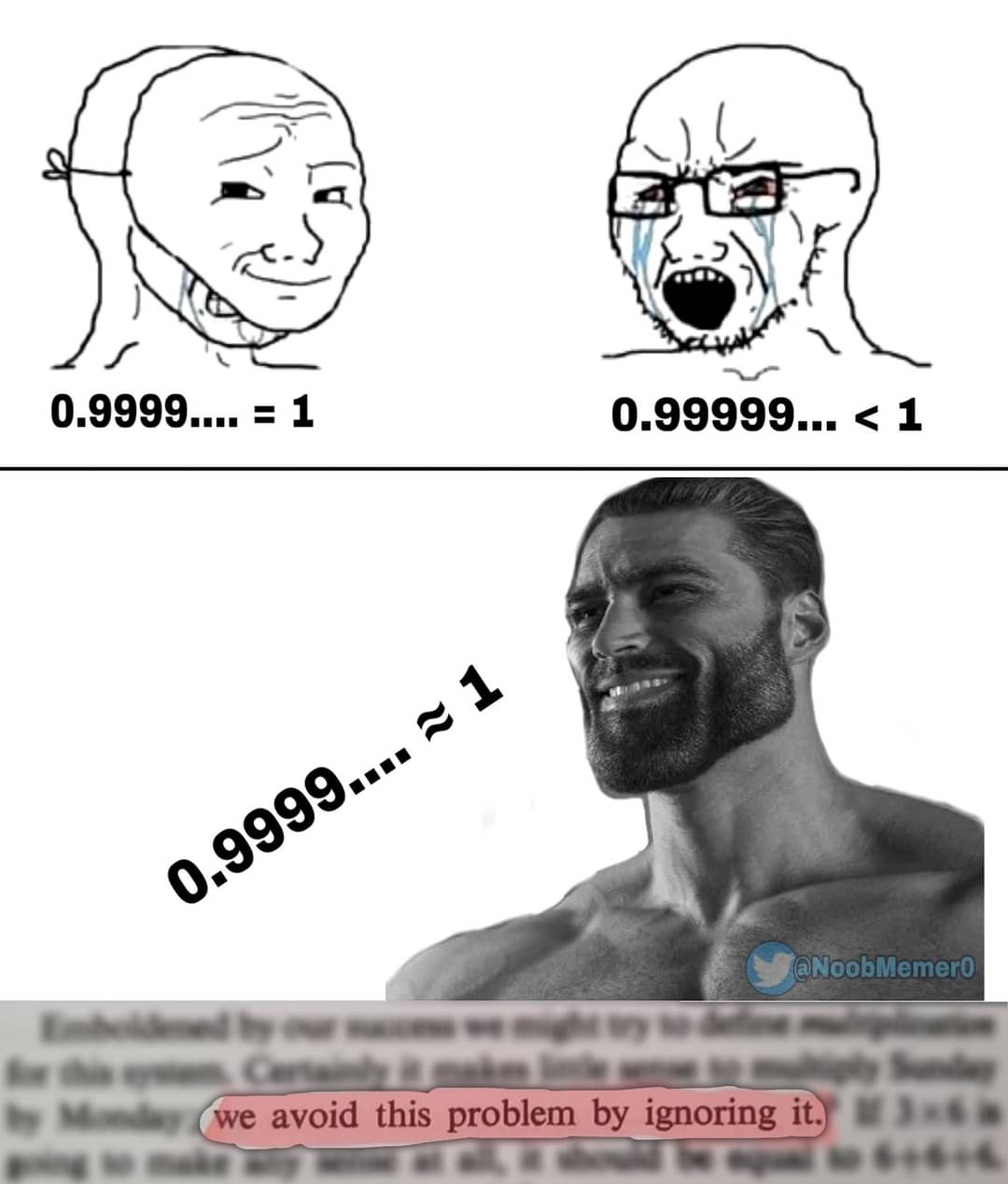this post was submitted on 27 Jun 2024
819 points (95.2% liked)
Science Memes
15424 readers
1900 users here now
Welcome to c/science_memes @ Mander.xyz!
A place for majestic STEMLORD peacocking, as well as memes about the realities of working in a lab.

Rules
- Don't throw mud. Behave like an intellectual and remember the human.
- Keep it rooted (on topic).
- No spam.
- Infographics welcome, get schooled.
This is a science community. We use the Dawkins definition of meme.
Research Committee
Other Mander Communities
Science and Research
Biology and Life Sciences
- !abiogenesis@mander.xyz
- !animal-behavior@mander.xyz
- !anthropology@mander.xyz
- !arachnology@mander.xyz
- !balconygardening@slrpnk.net
- !biodiversity@mander.xyz
- !biology@mander.xyz
- !biophysics@mander.xyz
- !botany@mander.xyz
- !ecology@mander.xyz
- !entomology@mander.xyz
- !fermentation@mander.xyz
- !herpetology@mander.xyz
- !houseplants@mander.xyz
- !medicine@mander.xyz
- !microscopy@mander.xyz
- !mycology@mander.xyz
- !nudibranchs@mander.xyz
- !nutrition@mander.xyz
- !palaeoecology@mander.xyz
- !palaeontology@mander.xyz
- !photosynthesis@mander.xyz
- !plantid@mander.xyz
- !plants@mander.xyz
- !reptiles and amphibians@mander.xyz
Physical Sciences
- !astronomy@mander.xyz
- !chemistry@mander.xyz
- !earthscience@mander.xyz
- !geography@mander.xyz
- !geospatial@mander.xyz
- !nuclear@mander.xyz
- !physics@mander.xyz
- !quantum-computing@mander.xyz
- !spectroscopy@mander.xyz
Humanities and Social Sciences
Practical and Applied Sciences
- !exercise-and sports-science@mander.xyz
- !gardening@mander.xyz
- !self sufficiency@mander.xyz
- !soilscience@slrpnk.net
- !terrariums@mander.xyz
- !timelapse@mander.xyz
Memes
Miscellaneous
founded 2 years ago
MODERATORS
you are viewing a single comment's thread
view the rest of the comments
view the rest of the comments

The ellipsis notation generally refers to repetition of a pattern. Either ad infinitum, or up to some terminus. In this case we have a non-terminating decimal.
0.999... is a real number, and not any object that can be said to converge. It is exactly 1.
In what way is it distinct?
And what is a 'repeating number'? Did you mean 'repeating decimal'?
Ok. In mathematical notation/context, it is more specific, as I outlined.
This technicality is often brushed over or over simplified by math teachers and courses until or unless you take some more advanced courses.
Context matters, here's an example:
Generally, pdf denotes the file format specific to adobe reader, while in the context of many modern online videos/discussions, it has become a colloquialism to be able to discuss (accused or confirmed) pedophiles and be able to avoid censorship or demonetization.
Ok. Never said 0.999... is not a real number. Yep, it is exactly 1 because solving the equation it truly represents, a geometric series, results in 1. This solution is obtained using what is called the convergence theorem or rule, as I outlined.
0.424242... solved via the convergence theorem simply results in itself, as represented in mathematical nomenclature.
0.999... does not again result in 0.999..., but results to 1, a notably different representation that causes the entire discussion in this thread.
I meant what I said: "know patterns of repeating numbers after the decimal point."
Perhaps I should have also clarified known finite patterns to further emphasize the difference between rational and irrational numbers.
EDIT: You used a valid and even more mathematically esoteric method to demonstrate the same thing I demonstrated elsewhere in this thread, I have no idea why you are taking issue with what I've said.
It is not. You will routinely find it used in cases where your explanation does not apply, such as to denote the contents of a matrix.
Furthermore, we can define real numbers without defining series. In such contexts, your explanation also doesn't work until we do defines series of rational numbers.
In which case it cannot converge to anything on account of it not being a function or any other things that can be said to converge.
A series is not an equation.
What theorem? I have never heard of 'the convergence theorem'.
What do you mean by 'solving' a real number?
In what way does it not 'result in 0.999...' when 0.999... = 1?
You seem to not understand what decimals are, because while decimals (which are representations of real numbers) '0.999...' and '1' are different, they both refer to the same real number. We can use expressions '0.999...' and '1' interchangeably in the context of base 10. In other bases, we can easily also find similar pairs of digital representations that refer to the same numbers.
What we have after the decimal point are digits. OTOH, sure, we can treat them as numbers, but still, this is not a common terminology. Furthermore, 'repeating number' is not a term in any sort of commonly-used terminology in this context.
The actual term that you were looking for is 'repeating decimal'.
No irrational number can be represented by a repeating decimal.
https://www2.kenyon.edu/Depts/Math/Paquin/GeomSeriesCalcB.pdf
Here's a standard introduction to the concept of the Convergence/Divergence Theorem of Geometric Series, starts on page 2.
Its quite common for this to be referred to as the convergence test or rule or theorem by teachers and TA's.
Now, ask yourself this question, 'is 0.999..., or any real number for that matter, a series?'. The answer to that question is 'no'.
You seem to be extremely confused, and think that the terms 'series' and 'the sum of a series' mean the same thing. They do not. 0.999... is the sum of the series 9/10+9/100+9/1000+..., and not a series itself.
EDIT: Also, the author does abuse the notations somewhat when she says '1+1/2+1/4 = 2' is a geometric series, as the geometric series 1+1/2+1/4+... does not equal 2, because a series is either just a formal sum, a sequence of its terms, or, in German math traditions, a sequence of its partial sums. It is the sum of the series 1+1/2+1/4+... that is equal to 2. The confusion is made worse by the fact that sums of series and the series themselves are often denoted in the same way. However, again, those are different things.
Would you mind providing a snippet with the definition of the term 'series' that she provides?
EDIT 2: Notably, that document has no theorem that is called 'convergence theorem' or 'the convergence theorem'. The only theorem that is present there is the one on convergence and divergence of geometric series.